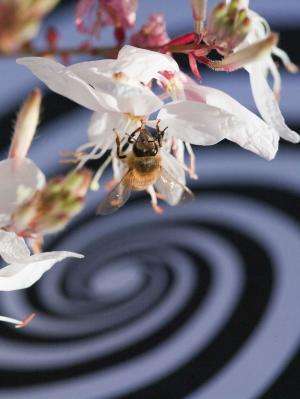October 29, 2013 report
Study shows bees use visual rate of expansion of ground for perfect landings

(Phys.org) —An international team of researchers has found that bees use a simple visual technique when landing, either horizontally or vertically. In their paper published in Proceedings of the National Academy of Sciences, the team describes how they filmed bees landing in their lab and in studying the tape discovered how it is they manage to land nearly perfectly every time.
When humans try to teach robots how to land they use all sorts of sophisticated technology, most of which is geared towards measuring how far away the ground is, how fast the vehicle is traveling and in which direction. The team working on this new effort at the Australian National University found that bees use a far simpler approach—they note how fast the target appears to be expanding as they move towards it, and adjust their speed accordingly.
The idea is that as an object moves closer to the ground, the ground and everything on it appears to expand. If that same object moves at a constant rate, the ground seems to expand at an accelerating rate. On the other hand, if the object adjusts its speed so that the object appears to expand at a constant rate, the object will slow, resulting in zero speed at the touchdown point. And that, the researchers found, is exactly how bees land so well despite having very little brains. The researchers discovered this by filming bees as they flew and landed in their lab, and then analyzed their flight behavior. They also added a spinning spiral disk as a backdrop. If a spiral is drawn and then spun in one direction, and then approached, it appears as if the surface is expanding faster than it really is—spun the other way, it appears as if the surface is expanding slower than it really is. As the bees approached the spiral to land, they adjusted their speed and either came in too slow or too fast, proving they were using visual expansion information to control their landings.
The researchers believe their findings should prove helpful for those programming drones or other robotic craft to land on their own—allowing for an inexpensive way to land without broadcasting radar signals to others in the vicinity.
More information: A universal strategy for visually guided landing, PNAS, Published online before print October 28, 2013, DOI: 10.1073/pnas.1314311110
Abstract
Landing is a challenging aspect of flight because, to land safely, speed must be decreased to a value close to zero at touchdown. The mechanisms by which animals achieve this remain unclear. When landing on horizontal surfaces, honey bees control their speed by holding constant the rate of front-to-back image motion (optic flow) generated by the surface as they reduce altitude. As inclination increases, however, this simple pattern of optic flow becomes increasingly complex. How do honey bees control speed when landing on surfaces that have different orientations? To answer this, we analyze the trajectories of honey bees landing on a vertical surface that produces various patterns of motion. We find that landing honey bees control their speed by holding the rate of expansion of the image constant. We then test and confirm this hypothesis rigorously by analyzing landings when the apparent rate of expansion generated by the surface is manipulated artificially. This strategy ensures that speed is reduced, gradually and automatically, as the surface is approached. We then develop a mathematical model of this strategy and show that it can effectively be used to guide smooth landings on surfaces of any orientation, including horizontal surfaces. This biological strategy for guiding landings does not require knowledge about either the distance to the surface or the speed at which it is approached. The simplicity and generality of this landing strategy suggests that it is likely to be exploited by other flying animals and makes it ideal for implementation in the guidance systems of flying robots.
Journal information: Proceedings of the National Academy of Sciences
© 2013 Phys.org




















